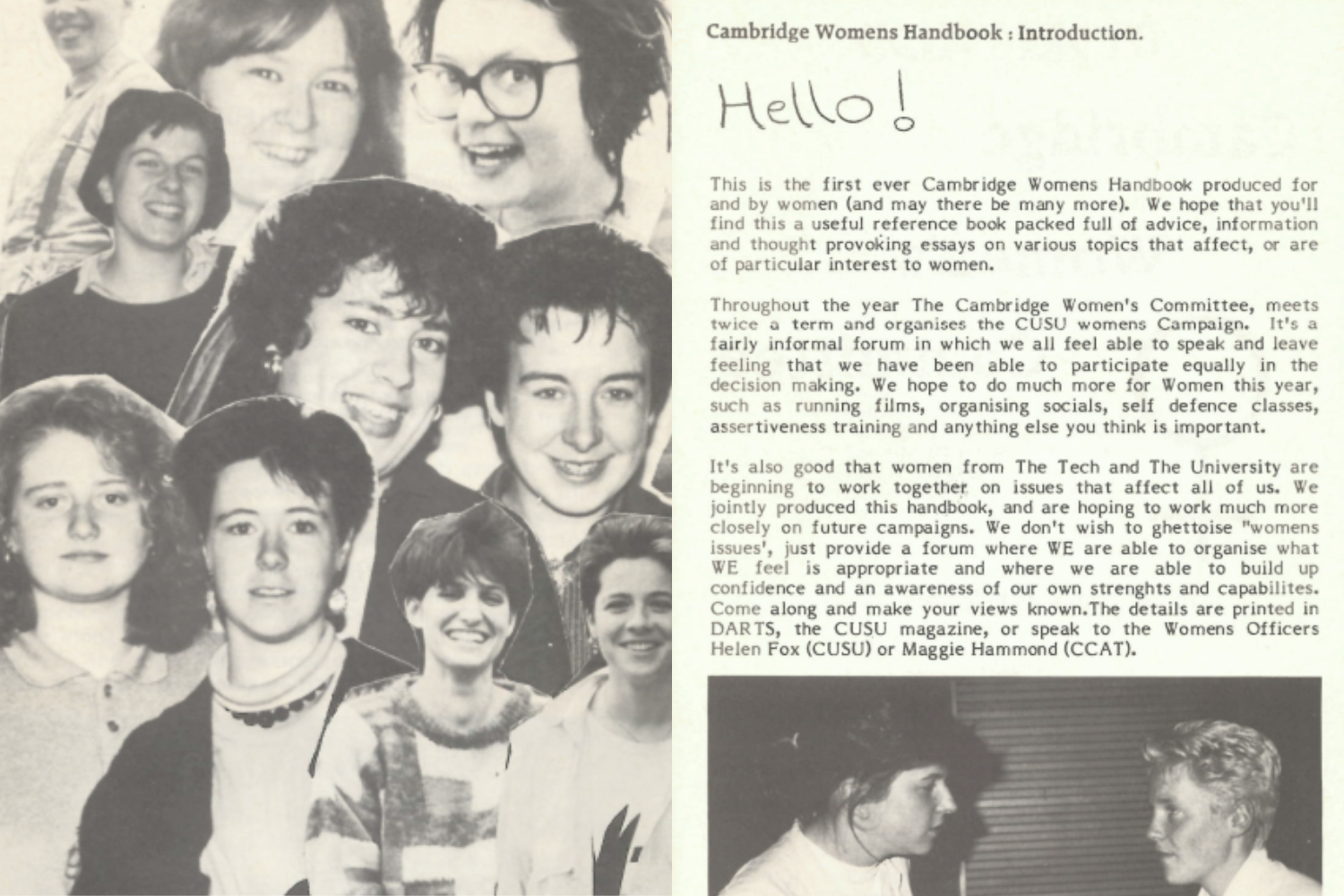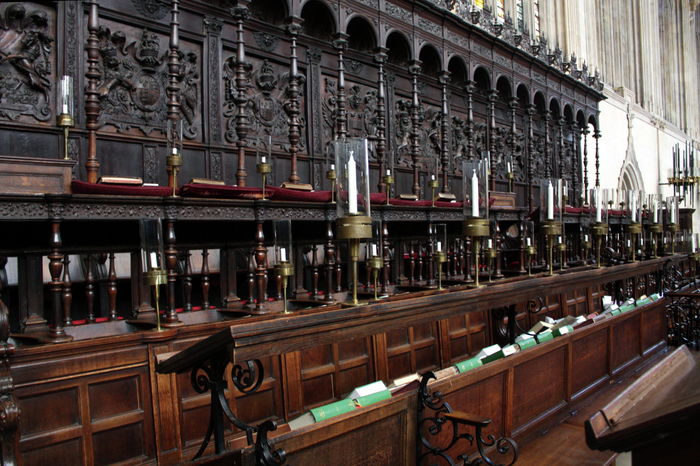“Did you know there used to be a Women’s Handbook?” I’ve been asking all of my friends this for the last few months, and everyone has said no. I’d heard about it during an interview, and been told it was a book the SU published to help women when they came to Cambridge, that they would stick it in your pidge on your first day here. But online, there is no record. I expected a few funny cartoons and some writing on supervisors that perhaps ran for half a decade at most. But the Women’s Handbook I found was enormous, it was decidedly political and it ran for over two decades. So, what happened to it?
The search started in an SU store room. I’d scoured iDiscover to little avail: a reference entry in Peterhouse, a copy in Medwards, a couple in the UL I could order from their warehouse. A filing cabinet seemed promising, but the draw marked ‘W’ only held dusty bottles of Sainsbury’s own wine. I hit a treasure trove of old SU zines hidden behind one of the posters I’d seen at the Fresher’s Fairs. There were far more documents than I expected: a monthly magazine dedicated to helping FTM people feel comfortable in their transition dated back to 2006; copies of No Definition from 2009 gave voices to queer people; ‘The little red book’ had blue, green, and black siblings, some with advice on sexual health, and safe drug use.
The SU store room, borderline falling apart, was rich political history the SU had funded. Politics that was student-led and actively worked to assist and orient students during their time here, was now hidden under a stack of posters. Pages and pages of evidence of a discursive political atmosphere that had been present in Cambridge for decades; now, entirely alien to me. But still no Women’s Handbook.
“Pages and pages of evidence of a discursive political atmosphere that had been present in Cambridge for decades; now, entirely alien to me”
I did find though, A Women’s Guide to Cambridge, written in 1983 by Dr. Sue Oosthuizen while she studied at Darwin. This was not the handbook I was hunting for, but it was something. A Women’s Guide is a historical account of women in Cambridge, it takes you on a walk through the town and tells you the stories of the women who have lived here. Sue told me it took her hours of research, the actual printing done on a long dead socialist printer on Mill Road. “It was about situating yourself in a political context as a woman.” She worries about my generation, fearing we’re not engaged enough with activism. A Women’s Guide foregrounds our existence here, it evidences the long road we’ve travelled.
Eventually, I got my hands on the copies of the Women’s Handbook. They’d been moved out of the store room by recently resigned Women’s Officer Rosie Freeman, and sat in boxes next to her desk along with piles of old Women’s Campaign work.
A hand-drawn “Hello!” is a reader’s introduction to the first ever Women’s Handbook, produced by Helen Fox and Maggie Hammond in 1987. “This is the first ever Cambridge Women’s Handbook produced for and by women (and may there be many more),” the pair wrote. These editions were produced in collaboration between Anglia Ruskin and Cambridge University, the aim, as the Handbook recounts, was “to work together on issues that affect us all.” Coming together seems to be the governing principle for these early editions, with academics and students producing the book together. Dr Lisa Jardin, Jesus College’s first female fellow, wrote an article called ‘Problems with Studying in a Male Dominated Environment’. Her main piece of advice is that female academics will have your back: “Go to a friendly senior member […] she can, and almost certainly always will help.” There seemed to be a different culture of female solidarity then.
The Handbook records articles written by a variety of academics. “Everything that we were doing on contraception and sexual health, many people just didn’t know,” Liz Stanley, the editor of the publication from 1990 to 1992, told me. “What we were trying to do on that practical level was to get over the barrier for women getting this information. The Handbook would be in your pigeon hole on your first day, so if you needed it, it was there.”
“She worries about my generation, fearing we’re not engaged enough with activism”
But the Handbooks were not just spaces for advice. National campaigns stemming from NUS conferences turned the Handbook into a space to not only educate, but also advocate for political action. For Liz, the publication was a “recognition that we are marginalised, and the culture of this University can be really hostile; it was about collective action.” She told me about the national campaign to get pornography banned from WHSmith: “The NUS’ direct action plan told us to go into Smiths, take some porn mags off the shelf, and demand we speak to a manager,” Liz recalled, “but honestly, I think most of us were too anxious to do that. Instead, we went in as a collective.” A photo from a 1991 edition of The Cambridge Evening Press shows Liz handing over the petition to remove porn from WHSmith. She still remembers being told to “smile” for the picture by the male photographer. Thankfully, she didn’t.
When I remarked about how different feminism in Cambridge seems to be now, Liz warned me about the dangers of putting the past on a pedestal: “Before you get too rosy a view of it, there were a lot of women who hated us. I remember one woman saying that we were just not getting enough sex. A lot of people thought that; we were not massively popular.” She was keen to remind me, as was Sue Oosthuizen, that the women who worked on the projects are not so different from myself.
Through the 90s, the publication retained its discursive politics and featured a section of literary writing on feminist issues. Eventually, this was taken out of the Handbook and put into a separate publication, Gender Agenda. The politics of early editions waned in the 2000s as JP Morgan sponsorships lined the footer of the pages; the last edition in the SU archives is from 2009 to 2010 and it was full of notes from that year’s Women’s Officer, one reading “TOO MUCH! Should be online.”
“We need a feminist renaissance. We need people who aren’t afraid”
College student unions slowly disaffected from the SU, and with them went their funding. CUSU had been reliant on money from colleges to print the Women’s Handbook: in 1987, Sian Griffiths spoke to Varsity about the Handbook’s struggles with money: “We’ll still have to rely on getting a lot of money from colleges.” We don’t receive a Women’s Handbook any longer, and there is no concrete record of its demise, but it seems the publication fell victim to death by a thousand papercuts.
Back in the SU offices, I tried to see if Rosie knew anything concrete but I left empty handed. This was not a documented death. I told Rosie what I’d found out about the Handbook, about the marches and petitions, as well as the direct action and policy changes that went along with it. We were both left upset about what feminism has become today: “We need a feminist renaissance. We need people who aren’t afraid,” she said. But Rosie doesn’t seem afraid. In her time as Women’s Officer she was active in getting publications up and running and she helped porters get trained in spiking prevention at Caius. Compared to what Liz Stanley told me was “a team of officers, one from every college” with funding coming from the colleges themselves, the Women’s Campaign is a shell of its former self with only a small number of officers, the majority of whom are co-opted in.
“I am the last Women’s Officer left,” Rosie told me. The National Union of Students have got rid of the position of a full-time Women’s Officer, a position the editors of the first ever Handbook stoically campaigned for in the ’87 edition. “Women’s Officers are now part-time roles,” she said, “it’s all been integrated into an Equality and Liberation Officer. You don’t necessarily have to integrate as much liberation work into your student union if it is just one person; it’s quite easy to ignore one person.”
I can’t tell you exactly what killed the Women’s Handbook, or where the political organising of the women I spoke to went. The last mention of the Women’s Handbook on the CUSU website is from 2012, even here only mentioning “events for 2008-2009”. While there is nothing concrete about the death of the publication, it is one which reflects the culture of apathy that now surrounds student politics. If you mention the SU to anyone now, they will probably tell you that it does nothing. But it used to do a lot; there used to be a lot of people who turned up to help create it. There used to be a Women’s Handbook.


